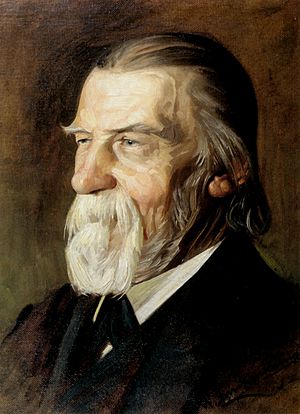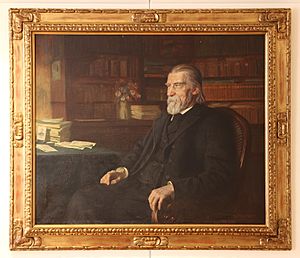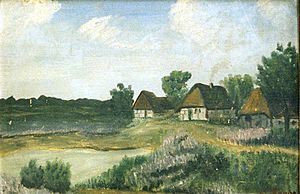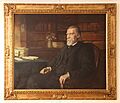Wilhelm Raabe facts for kids
Wilhelm Raabe (born September 8, 1831, died November 15, 1910) was a famous German novelist. He wrote many stories and books. When he first started writing, he used a special pen name, or fake name, which was Jakob Corvinus.
Contents
Wilhelm Raabe's Early Life and Education
Wilhelm Raabe was born in a town called Eschershausen. This town was part of the Duchy of Brunswick back then. He went to schools called gymnasia in Holzminden and Wolfenbüttel. These schools were like high schools today.
In 1849, when he was 18, he started working as an apprentice in a bookstore in Magdeburg. An apprentice is someone who learns a job by working with an expert. This job gave him a great chance to read many books. He learned a lot about stories and folklore from Germany and other countries. He worked there until 1854.
Becoming a Writer: From Student to Author
Wilhelm Raabe eventually got tired of the daily routine at the bookstore. So, he decided to study philosophy at Berlin University. He studied there from 1855 to 1857.
While he was a student, he published his very first book. It was called The Chronicle of Sparrow Lane (1857) (in German, Die Chronik der Sperlingsgasse). He used his pen name, Jakob Corvinus, for this book. The book was about everyday life for people in Germany and quickly became very popular.
Because his first book was so successful, Raabe decided to stop his studies. He wanted to focus only on writing. He moved back to Wolfenbüttel, then lived in Stuttgart from 1862 to 1870. After that, he returned to Brunswick. He kept writing until the end of the 1800s. He wrote more than 30 novels and many short stories.
Wilhelm Raabe's Writing Style and Periods
Wilhelm Raabe's writing career can be split into three main parts. Each part shows a different style or focus in his stories.
First Period: Light and Imaginative Stories
In his first period of writing, Raabe wrote with a light and cheerful style. He used his imagination and experiences to create many pictures of German life. Some of his well-known works from this time include:
- Die Chronik der Sperlingsgasse (1856)
- Die Kinder von Finkenrode (1859)
- Unser Herrgotts Kanzlei (1862)
Second Period: Deeper and More Serious Themes
During his second period, Raabe's writing became more serious. You can see the influence of a philosopher named Schopenhauer, who often wrote about sad or difficult ideas. Important books from this time are:
- Der Hungerpastor (1864)
- Abu Telfan (1867)
- Der Schüdderump (1870)
These three books are sometimes called a "trilogy." This means they are a group of three works, even though their stories are separate. They show a special time in Raabe's life and writing.
Third Period: Humor and Serious Subjects Combined
In the third part of his writing life, Raabe's books became more hopeful and often included humor. This humor reminds some people of the famous English writer Charles Dickens. Even though his stories were often funny, they still dealt with serious topics.
Horacker (1876) is a great example of this style and is often called his best work. Other books from this time include Der Dräumling (1872) and Deutscher Mondschein (1873). Later works like Das Odfeld (1889) and Die Akten des Vogelsangs (1895) were also very popular. Kloster Lugau (1894) and Hastenbeck (1899) also belong to this period.
Influences on His Writing
Early in his career, Raabe was inspired by another writer named Jean Paul. Later, he seemed to have read and been influenced by writers like Charles Dickens and Thackeray.
Wilhelm Raabe's Legacy and Recognition
The German people really admired Wilhelm Raabe. They showed their appreciation especially during his 70th birthday celebration in 1901. Starting in 1965, a special collection of all his works was published. It was called Sämtliche Werke (Braunschweiger Ausgabe). This shows how important his writings were.
Wilhelm Raabe the Painter
Many people don't know that Wilhelm Raabe also had a talent for painting! He created about 600 paintings. Some of these paintings are still owned by his family, and others are in the Braunschweig Museum.
Images for kids
See also
 In Spanish: Wilhelm Raabe para niños
In Spanish: Wilhelm Raabe para niños







